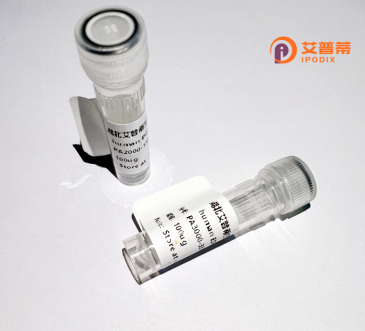
| 纯度 | >90%SDS-PAGE. |
| 种属 | Human |
| 靶点 | BBS4 |
| Uniprot No | Q96RK4 |
| 内毒素 | < 0.01EU/μg |
| 表达宿主 | E.coli |
| 表达区间 | 1-519aa |
| 氨基酸序列 | MAEERVATRT QFPVSTESQK PRQKKAPEFP ILEKQNWLIH LHYIRKDYEA CKAVIKEQLQ ETQGLCEYAI YVQALIFRLE GNIQESLELF QTCAVLSPQS ADNLKQVARS LFLLGKHKAA IEVYNEAAKL NQKDWEISHN LGVCYIYLKQ FNKAQDQLHN ALNLNRHDLT YIMLGKIHLL EGDLDKAIEV YKKAVEFSPE NTELLTTLGL LYLQLGIYQK AFEHLGNALT YDPTNYKAIL AAGSMMQTHG DFDVALTKYR VVACAVPESP PLWNNIGMCF FGKKKYVAAI SCLKRANYLA PFDWKILYNL GLVHLTMQQY ASAFHFLSAA INFQPKMGEL YMLLAVALTN LEDIENAKRA YAEAVHLDKC NPLVNLNYAV LLYNQGEKKN ALAQYQEMEK KVSLLKDNSS LEFDSEMVEM AQKLGAALQV GEALVWTKPV KDPKSKHQTT STSKPASFQQ PLGSNQALGQ AMSSAAAYRT LPSGAGGTSQ FTKPPSLPLE PEPAVESSPT ETSEQIREK |
| 分子量 | 82.83 kDa |
| 蛋白标签 | GST-tag at N-terminal |
| 缓冲液 | 冻干粉 |
| 稳定性 & 储存条件 | Lyophilized protein should be stored at ≤ -20°C, stable for one year after receipt. Reconstituted protein solution can be stored at 2-8°C for 2-7 days. Aliquots of reconstituted samples are stable at ≤ -20°C for 3 months. |
| 复溶 | Always centrifuge tubes before opening.Do not mix by vortex or pipetting. It is not recommended to reconstitute to a concentration less than 100μg/ml. Dissolve the lyophilized protein in distilled water. Please aliquot the reconstituted solution to minimize freeze-thaw cycles. |
以下是关于BBS4蛋白的3篇代表性文献及其摘要概括:
1. **《BBS4 is a primary cilia protein important for leptin receptor signaling》**
- 作者:Seo S. et al.
- 摘要:研究揭示了BBS4定位于纤毛基体,并证明其缺失导致瘦素受体信号传导缺陷,与肥胖表型相关。敲除小鼠模型显示能量代谢异常,提示BBS4在调控体重中的作用。
2. **《Disruption of the basal body protein BBS4 causes Bardet-Biedl syndrome》**
- 作者:Mykytyn K. et al.
- 摘要:通过分析患者基因突变,发现BBS4突变导致纤毛结构和功能异常。蛋白参与基底体复合物组装,突变引发细胞内运输障碍,解释BBS综合征多器官表型。
3. **《BBS4 interacts with PCM1 and is required for centrosome clustering and microtubule anchoring》**
- 作者:Kim J.C. et al.
- 摘要:研究表明BBS4与中心体蛋白PCM1相互作用,调控微管锚定和纤毛形成。其缺失破坏细胞极性,支持BBS4在细胞骨架组织和纤毛发生中的关键角色。
以上研究涵盖BBS4在代谢、纤毛结构和细胞运输中的功能,均为该领域经典文献。
Bardet-Biedl syndrome 4 protein (BBS4) is a key component of the Bardet-Biedl syndrome (BBS) protein complex, linked to the autosomal recessive disorder Bardet-Biedl syndrome (BBS). BBS is a genetically heterogeneous ciliopathy characterized by retinal degeneration, obesity, polydactyly, renal abnormalities, and cognitive impairment. The BBS4 gene, located on human chromosome 15q24.1. encodes a protein critical for the assembly and function of primary cilia, sensory organelles involved in signaling pathways like Hedgehog and Wnt. BBS4 interacts with other BBS proteins (e.g., BBS1. BBS2) to form the "BBSome," a complex mediating cargo trafficking to ciliary membranes. Studies suggest BBS4 aids in stabilizing microtubule-based structures and regulating ciliary membrane protein localization. Mutations in BBS4 disrupt ciliary function, leading to impaired cell signaling and tissue development. Recombinant human BBS4. produced via expression systems like E. coli or mammalian cells, is widely used to study molecular mechanisms of BBS and cilia-related pathologies. Its structural domains, including proline-rich regions and α-helical motifs, are essential for interactions with cytoskeletal elements and other BBSome subunits. Research on recombinant BBS4 enhances understanding of ciliopathy pathogenesis and potential therapeutic strategies targeting ciliary dysfunction.
×